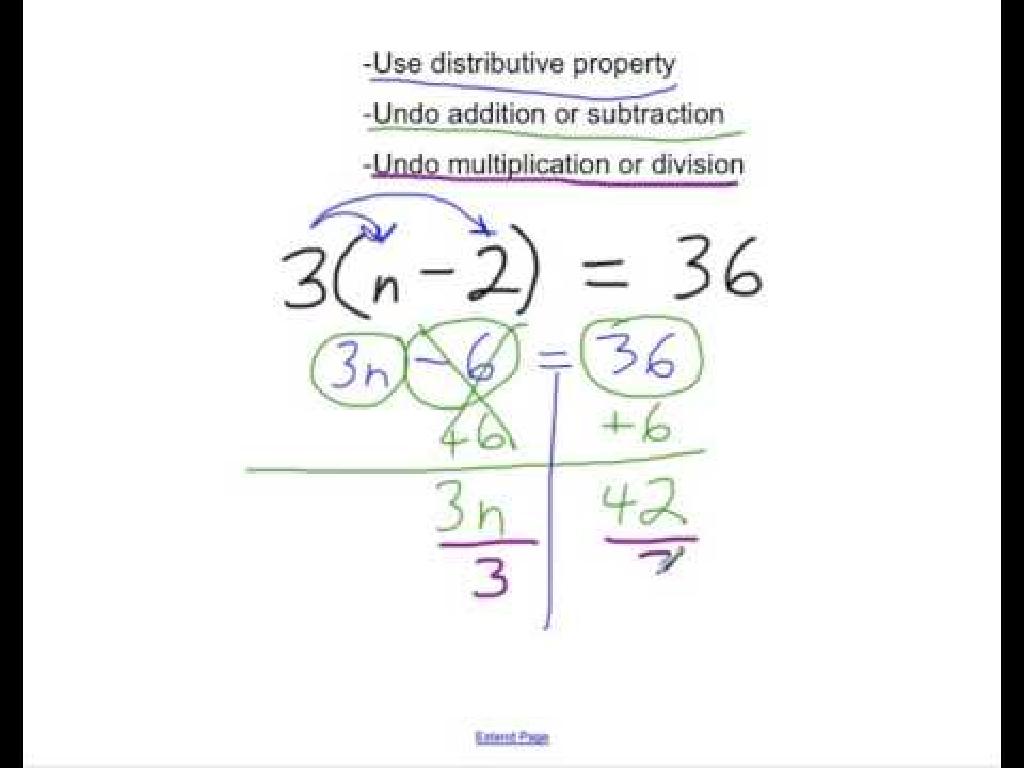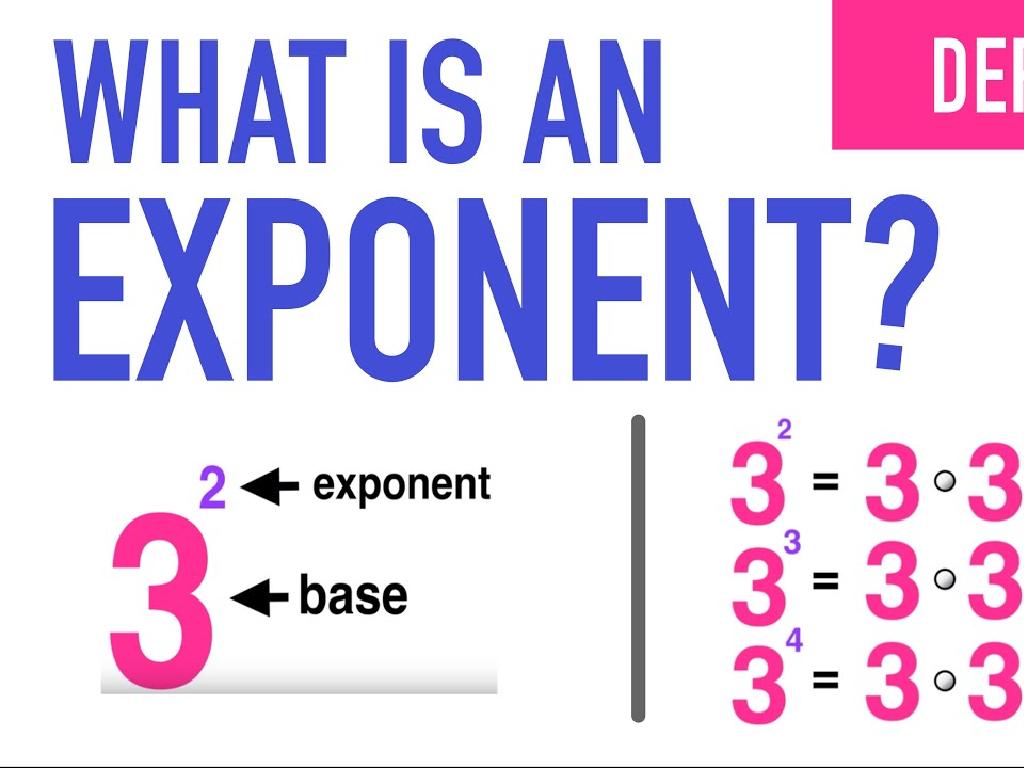Subtract A One-Digit Number From A Two-Digit Number Up To 18
Subject: Math
Grade: Second grade
Topic: Subtraction: One Digit
Please LOG IN to download the presentation. Access is available to registered users only.
View More Content
Welcome to Subtraction!
– Understanding subtraction
– Subtraction means finding out how many are left after taking some away.
– Subtraction: Taking away numbers
– If you have 18 apples and take away 1, you have 17 apples left.
– Share what you know about subtraction
– Let’s discuss what subtraction is and some examples you’ve seen.
|
This slide introduces the concept of subtraction to second graders. Begin by explaining that subtraction is simply the process of taking one number away from another. Use tangible examples, like apples, to illustrate the point. Ask the students to share their own experiences or prior knowledge about subtraction to make the lesson interactive and to assess their understanding. This will help in tailoring the lesson to the students’ needs and will encourage participation. The goal is to ensure that by the end of the lesson, students are comfortable with the basic idea of subtraction and can perform simple subtraction problems involving one-digit numbers from two-digit numbers up to 18.
Understanding Subtraction: Cookies Example
– Subtraction means taking away
– Example with 10 cookies
– Imagine a jar with 10 cookies inside
– Taking 2 cookies away
– If we remove 2 cookies, how many are left?
– Let’s count the remaining cookies!
– We’ll count the cookies left to see the answer
|
This slide introduces the concept of subtraction to second graders by using a relatable example of taking cookies away from a jar. Start by explaining that subtraction is the process of taking some things away from a larger group and finding out how many are left. Use the example of 10 cookies in a jar and ask the students to visualize taking 2 cookies away. This will help them understand that subtraction is simply finding the difference after some items are removed. Encourage the students to count along as you demonstrate subtracting 2 cookies from 10. This interactive approach helps solidify the concept of subtraction in a fun and engaging way.
Subtraction Vocabulary
– Minuend: Starting number
– The total you begin with, like 10 cookies
– Subtrahend: Number taken away
– How many you give away, say 2 cookies
– Difference: Result after subtracting
– What’s left after giving away, here 8 cookies
– Example with cookies
|
This slide introduces the basic vocabulary of subtraction to second graders using a relatable example of cookies. Minuend is the total number of cookies we start with, which in this case is 10. Subtrahend is the number of cookies we decide to give away or take away from our starting number, here it is 2. The difference is the result we get after performing the subtraction, which would be 8 cookies left with us. Use real cookies or visual aids to demonstrate this concept in class, allowing students to physically subtract and count the remaining cookies to reinforce the concept.
Subtracting One-Digit from Two-Digit Numbers
– Understanding subtraction
– Using a number line
– A line with numbers in order helps us see the subtraction steps.
– Example: 15 – 7
– Start at 15, count back 7 steps to find the answer.
– Jump back 7 spaces
– Each jump back is subtracting one.
|
This slide introduces the concept of subtraction by using a number line, which is a visual tool that helps students understand the process of taking away. Begin by explaining that subtraction means taking away from a group. Show how a number line can be used to visually represent this by starting at the larger number and counting backwards. For the example 15 – 7, demonstrate how to start at 15 on the number line and make 7 jumps backwards to land on the answer, 8. Emphasize that each jump represents subtracting one unit. Encourage students to practice with different numbers and to use their fingers to ‘jump’ along an imaginary number line if a physical one isn’t available.
Let’s Practice Subtraction Together!
– I’ll write problems on the board
– We’ll solve them as a class
– Count backwards to subtract
– If we have 15 – 2, count back: 15, 14, 13
– Find the answer together
|
This slide is designed for an interactive class activity to practice subtraction. Write a series of subtraction problems on the board that involve subtracting a one-digit number from a two-digit number up to 18. Encourage the students to participate in solving the problems as a group. Remind them to use the counting backwards method to find the answer, which helps reinforce the concept of subtraction. For example, if the problem is 15 – 2, count back two numbers starting from 15 to get 13. This method is particularly effective for visual and kinesthetic learners. As students solve each problem, ensure they explain their thought process, which will help solidify their understanding and assist others who may be struggling with the concept.
Subtraction Word Problems
– Subtraction in stories
– Read and solve together
– Example: Sally’s balloons
– Sally starts with 16, loses 4. How many left?
– Find the missing balloons
– Use subtraction: 16 – 4 to solve
|
This slide introduces students to the concept of subtraction within the context of word problems, which helps them apply math to real-life situations. Start by explaining that subtraction isn’t just numbers; it can be part of a story. Read a story problem to the class and work through it together, demonstrating how to identify the numbers involved and the subtraction required. Use the example of Sally’s balloons to show a practical situation where subtraction is used. Encourage students to visualize the problem, perhaps by drawing it out or using physical objects, to better understand the concept of taking away and finding out how many are left.
Independent Practice: Try Subtraction!
– Attempt subtraction problems alone
– Use number lines and counting back
– Draw a line with numbers and hop backwards
– It’s okay to use objects for help
– Count objects like blocks or fingers to subtract
– Mistakes are part of learning
– Every mistake is a step towards mastering subtraction
|
This slide is meant for students to begin practicing subtraction problems independently, reinforcing the strategies taught in class. Encourage them to use number lines by drawing a line with numbers and visually hopping backwards to subtract. They can also use physical objects like blocks or their fingers to help understand the concept of taking away. Remind them that making mistakes is a natural part of the learning process and that each error helps them improve. Provide a variety of subtraction problems and ensure they feel comfortable trying on their own. Offer support and guidance as needed.
Class Activity: Subtraction Bingo
– Let’s play Subtraction Bingo!
– Listen for the subtraction problem
– Example: If I say 15 – 6, look for 9
– Find the answer on your bingo card
– Get five in a row to win!
|
This interactive activity is designed to help second graders practice subtraction in a fun and engaging way. Prepare bingo cards in advance with a variety of answers from subtraction problems that subtract a one-digit number from a two-digit number up to 18. As you call out different subtraction problems, students will search for the correct answer on their cards. The goal is to reinforce their subtraction skills while providing a playful competitive element. Make sure to rotate through a diverse set of problems to give all students a chance to participate. Have small prizes ready for the winners to celebrate their success. Additionally, prepare to assist any student who may struggle with finding the answers quickly.
Reviewing Subtraction Skills
– Recap of today’s subtraction
We learned how to subtract small numbers from bigger ones up to 18.
– Steps to solve subtraction
Find the difference by taking away the smaller number from the bigger number.
– Praise for today’s effort
– Encouragement for home practice
Keep practicing subtraction to become a math superstar!
|
This slide is meant to wrap up the lesson on subtraction. Start by asking the class what they learned about subtraction to reinforce their understanding. Then, invite a student to explain the process of solving a subtraction problem to ensure they can articulate the steps. Offer praise to the class for their hard work and encourage them to continue practicing at home to solidify their skills. You can suggest using toys or snacks for fun subtraction practice. Remind them that practice is key to becoming confident in math.





/mla_intext_citations.png)
